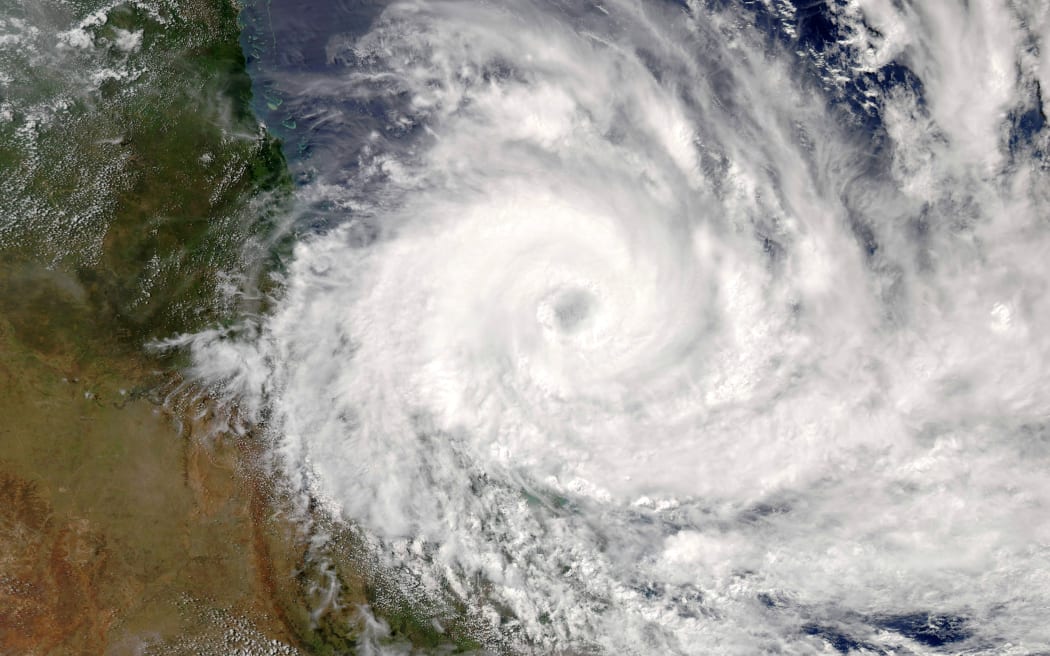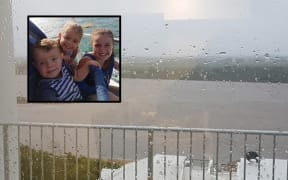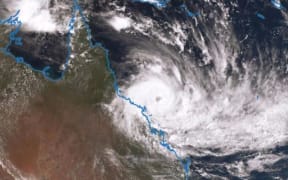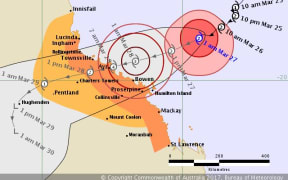As Cyclone Debbie bears down on the Queensland coast, here's a guide to how cyclones form, how destructive they can get, and how they get their names.

Cyclone Debbie can be seen closing in on the Australian coast in this NASA image. Photo: AFP
How do cyclones form?
Cyclones form with a combination of very warm sea surface temperatures and the right type of outflow. Imagine a tall chimney, where all the energy comes into the base and gets sucked up to the top.
A lot of energy gathers in one place, which often results in thunderstorms. In the right part of the ocean, the system can start circulating and release all that energy into the upper part of the atmosphere. The energy created from the thunderstorms can then add to the whole system and a tropical cyclone will form.
Cyclones rely on the circulation of Earth, so they form away from the equator. The effect of Earth spinning helps the whole system rotate.
Sea temperatures of 26.5°C or above, along with a group of thunderstorms or pre-existing conditions, create ideal weather conditions for a cyclone to form.
Hurricane Katrina, which hit New Orleans in 2005, formed in sea temperatures around 32°C or warmer. Temperatures of 31-32°C were measured off the West Australian coast in early 2011 as Cyclone Rusty formed.
The Madden-Julian Oscillation, a pattern that comes across the Indian and Pacific oceans, can help spin cyclones along. A new high pressure cell with a new surge of winds can also contribute.
What is the eye of a cyclone like?
The pressure is very deep inside the eye of a cyclone and there are very light winds, which can give a false sense of security. There is also an eerie sensation, as 200km/h winds can suddenly go calm. The winds can return to being just as strong as the cyclone continues to move over.
How destructive can cyclones be?
It depends how quickly they are moving and how deep they are. If you have pressure that continues to be created within the tropical cyclone down to about 850 hectopascals, they can be incredibly destructive.
The storm surge is a massive wall of water, akin to a tsunami, that can come out of the cyclone. The damage is caused not just by flooding and strong winds, but also by the actual force of the water moving at very high speeds.
Cyclone Larry made landfall in far north Queensland in 2006 with wind gusts reaching 240km/h, damaging more than half the homes in Innisfail and leaving a repair bill of $NZ1.5 billion.
Category four Cyclone Tracy hit Darwin on Christmas Eve in 1974 with winds of up to 217km/h per hour and killed 71 people. Tracy caused more than $867m in damage and destroyed about 80 percent of homes.
Cyclone Yasi hit north Queensland in February 2011, with wind gusts reaching 285km/h. It left a repair bill of about $867m after destroying homes, shredding crops and smashing marinas and island resorts. One man died from asphyxiation while sheltering in his home.
Does Australia have more cyclones than any other country?
No. There are other parts of the world such as the Philippines, the Gulf of Mexico, Florida and Louisiana that would be subject to more. However, Australia seems to be getting more intense tropical cyclones since the 1970s. There has been a 100 percent increase in categories four and five cyclones globally, but there has not been an increase in the number of cyclones.
The El Niño phenomenon, which occurs every three to seven years, usually sees a lower number of tropical cyclones, mostly confined to north-western Western Australia. In contrast, La Niña years tend to see more cyclones, particularly around the northern and eastern Australian coast.
The coast between Broome and Exmouth in WA is the most cyclone-prone part of Australia's coastline, and the region most prone to severe cyclone impacts. Since 1910 there have been more than 50 cyclones that have caused gale-force winds at Port Hedland. They come about once every two years, and about half have an impact equivalent to a category one cyclone. The strongest wind gust recorded at Port Hedland during a cyclone is 208km/h during Joan in 1975.
In general, cyclones near Australia have more erratic paths than cyclones in other parts of the world.
Is climate change a contributor to that?
Climate change would suggest warmer sea temperatures in some parts of the world, and warm sea temperatures create ideal conditions for cyclones to form.
The Australian Bureau of Meteorology says it is difficult to sort out natural trends, such as those caused by El Nino events, from the effects of global warming. Some studies cited by the bureau have predicted more severe storms by the middle of the 21st century, and storms that extend further towards the north and south poles. One study predicts more long-lived cyclones off the eastern coast of Australia and fewer long-lived cyclones off WA.
How do cyclones differ from tornados, hurricanes and typhoons?
Hurricanes and typhoons are regional names for severe tropical cyclones, or storms with sustained winds of more than 118km/h. The word hurricane is used for storms in the north Atlantic, the north-east Pacific, and the south-east Pacific. Typhoons are found in the north-west of the Pacific Ocean. Storm systems turn anti-clockwise in the Northern Hemisphere and clockwise in the Southern Hemisphere.
Tornados are born out of thunderstorms and are tiny by comparison - generally only about 100m across.
How are cyclone names chosen?
There is a committee at the World Meteorological Organisation in Geneva that decides the names many years in advance. They have a list of names for each region in the world that is responsible for identifying and classifying a tropical cyclone.
Importantly they never use the names of previous cyclones again in case some members of the public think Cyclone Tracy or Hurricane Katrina, for example, have come back. That is impossible, of course, but some may fear a cyclone with the same name might have the same impact.
- ABC





